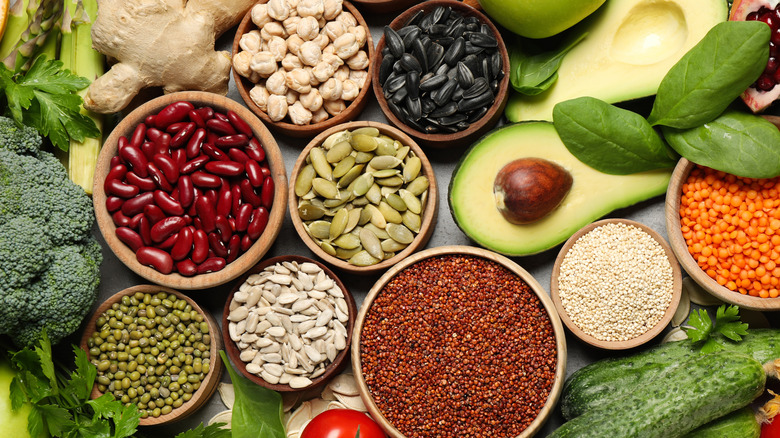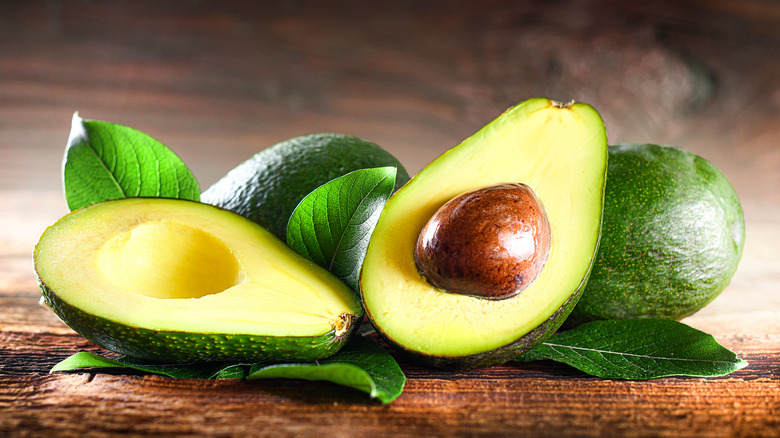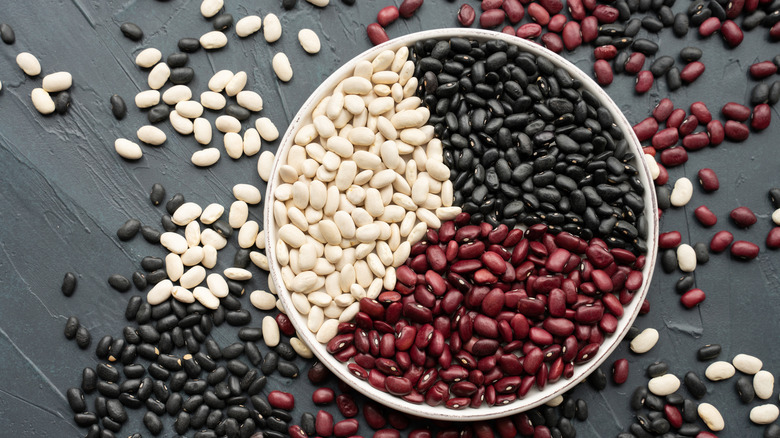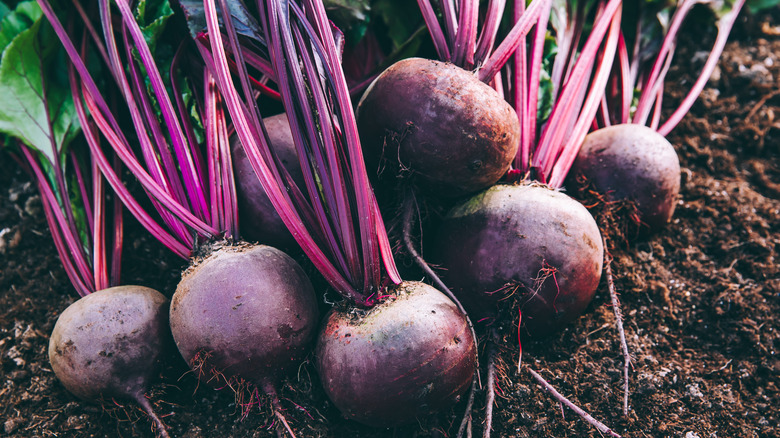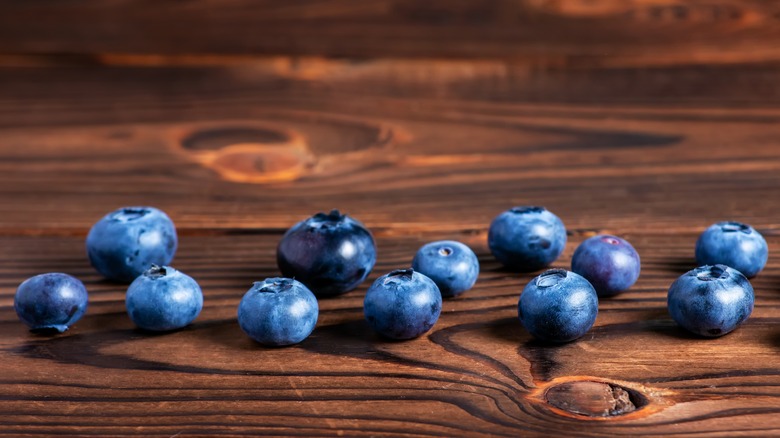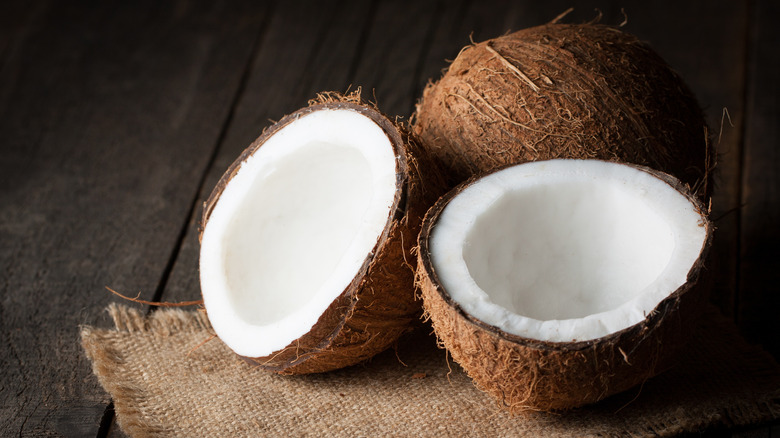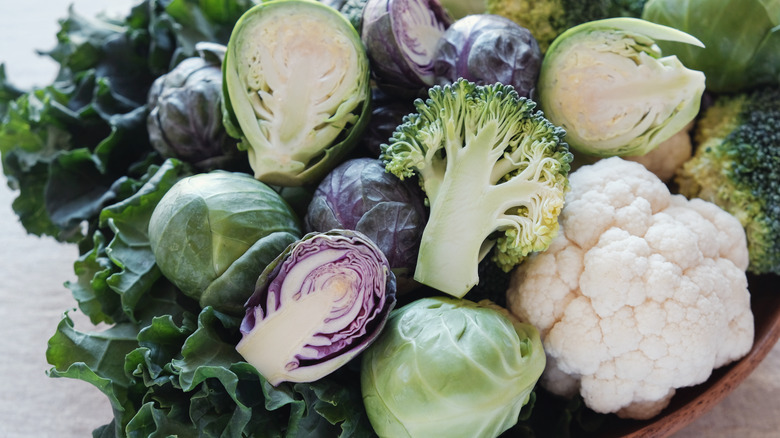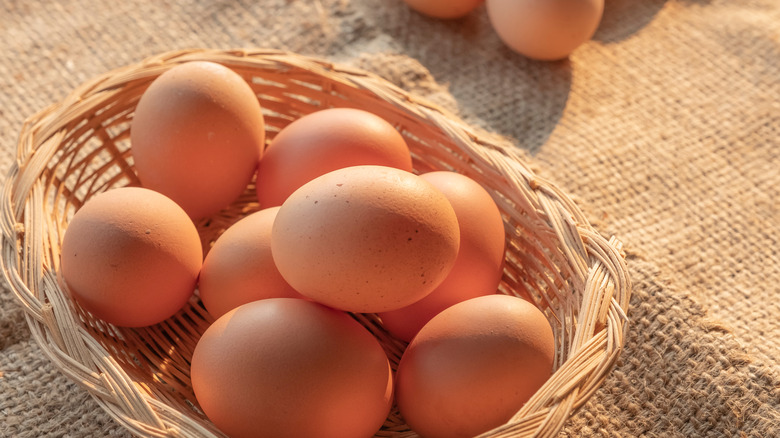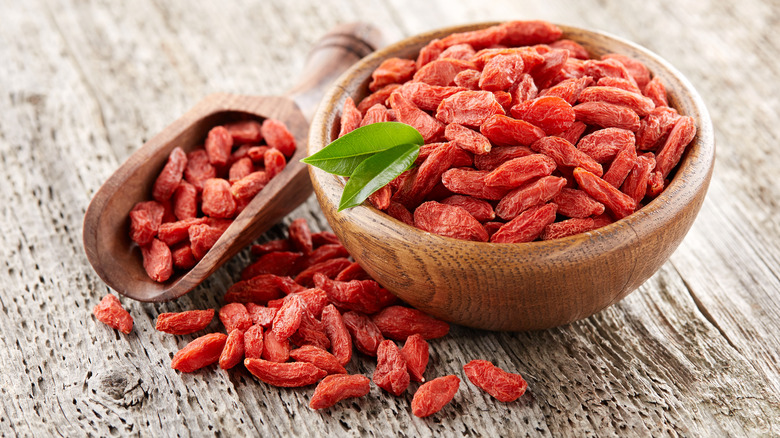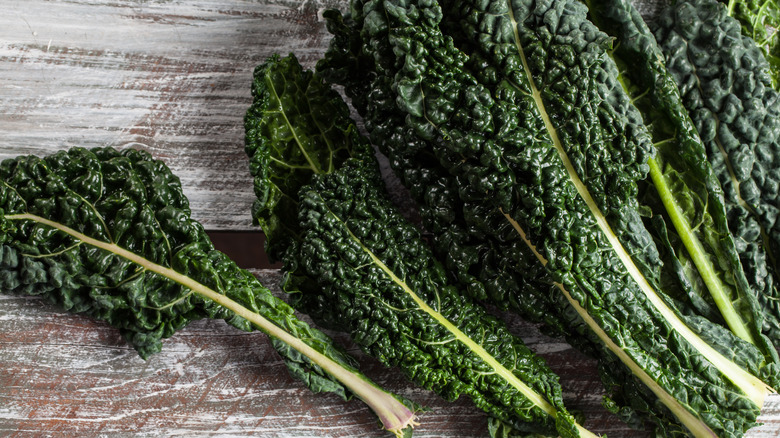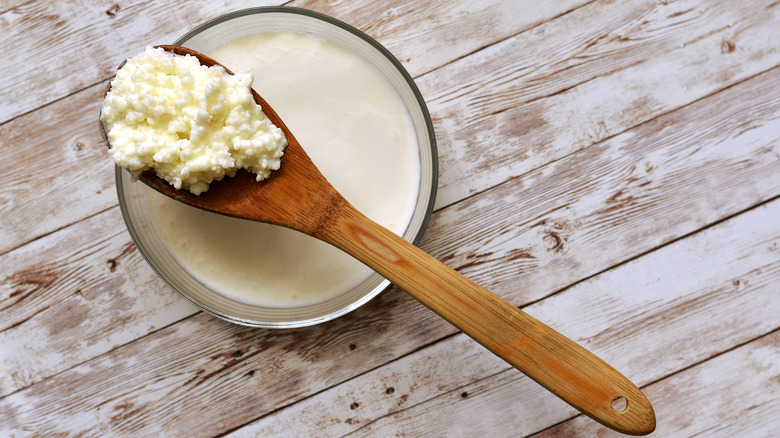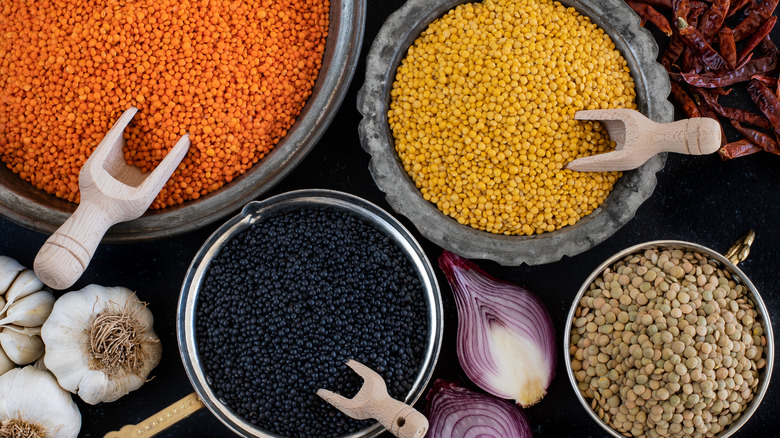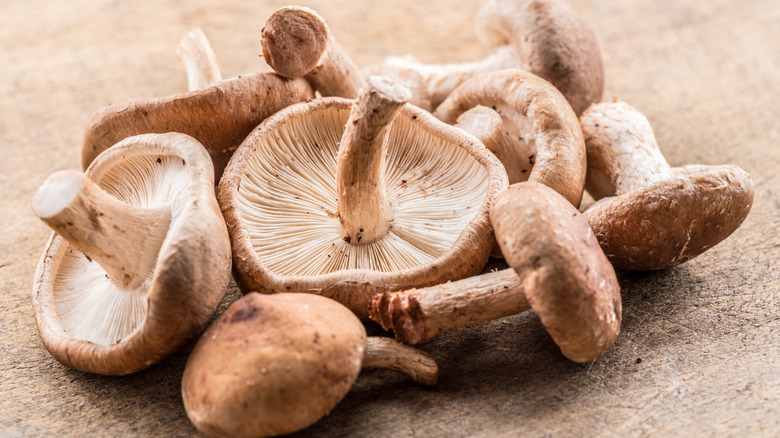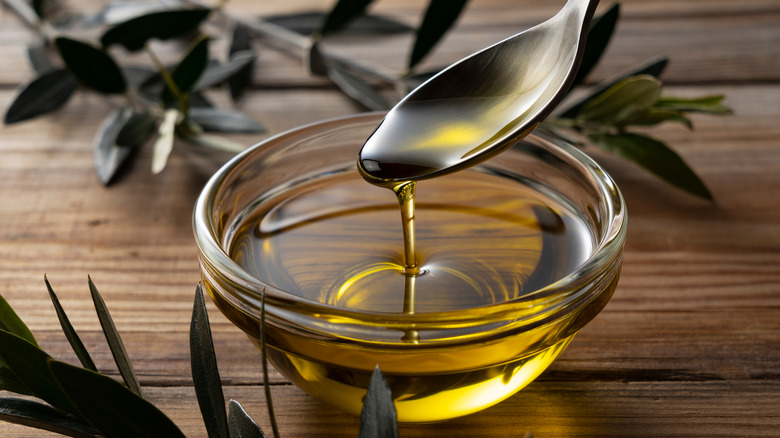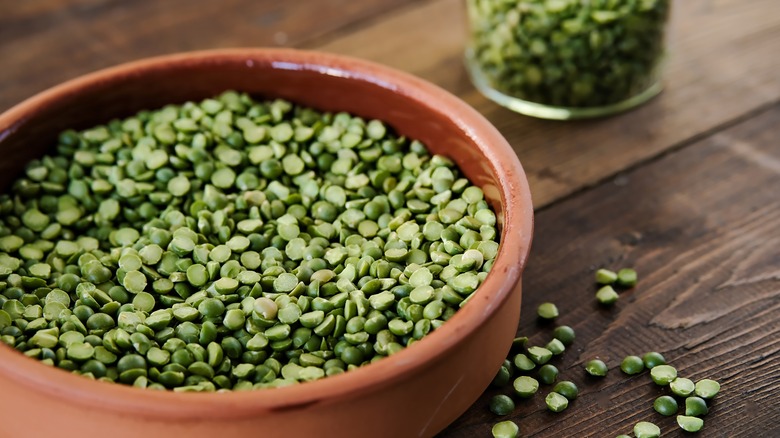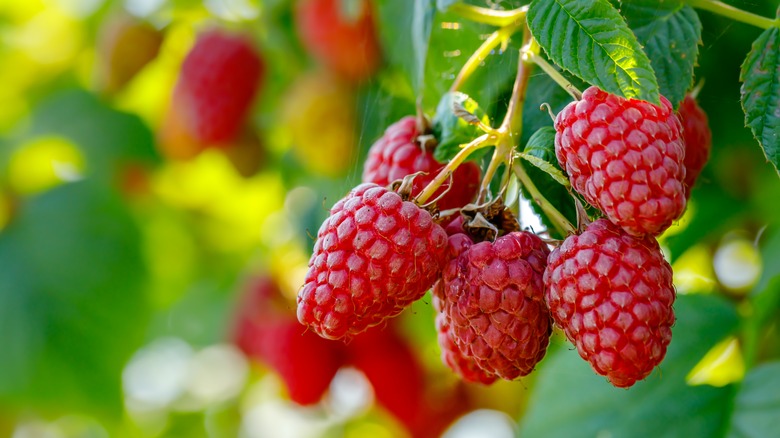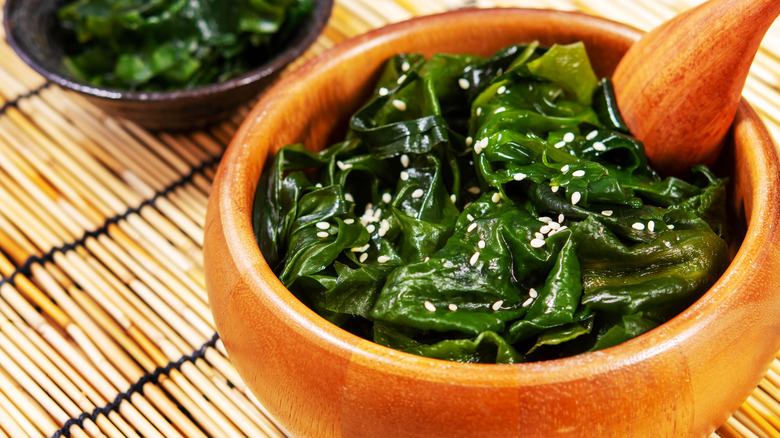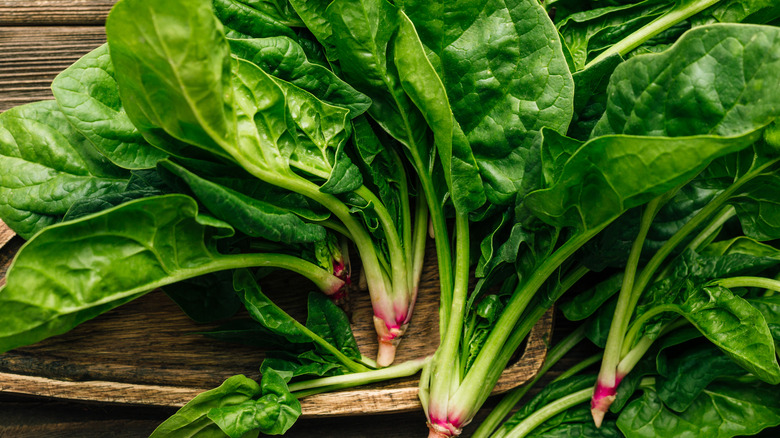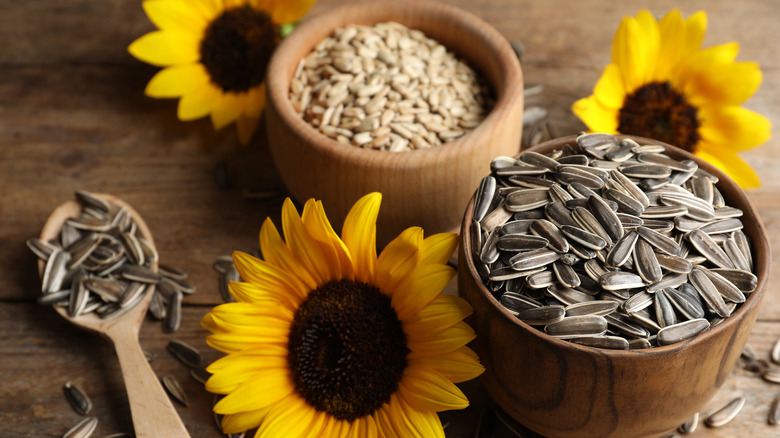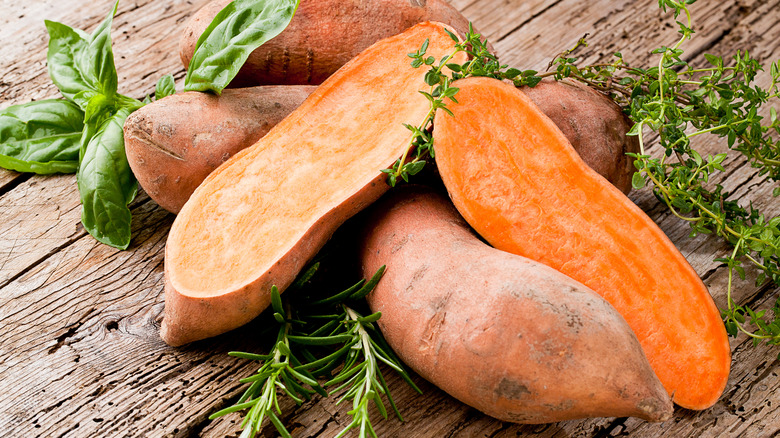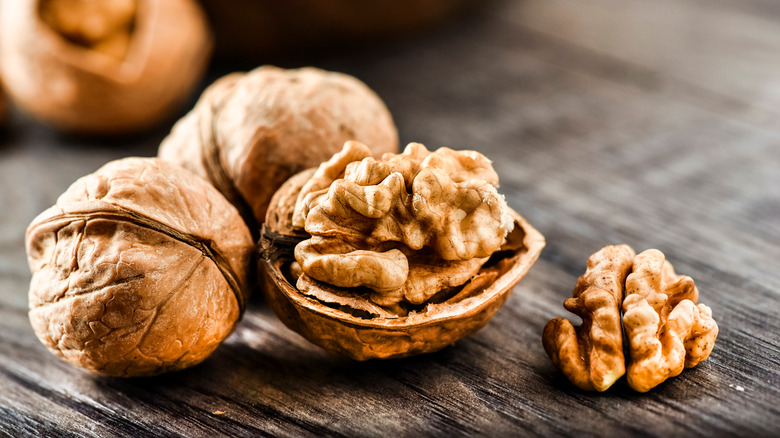20 Superfoods To Consider Adding To Your Diet
If the term superfood has you dreading a tasteless helping of bland diet food your mom swears is healthy, we've got really good news for you. As it turns out, many superfoods are incredibly tasty on their own — we're looking at you, raspberries and avocados — and all of these foods can be prepared in a dish (or many dishes) guaranteed to knock your culinary socks off. But before we dig into how to enjoy the healthiest foods available to us on this gorgeous green Earth of ours (and one from the beautiful blue ocean), let's distinguish exactly what a superfood is and where the heck that word came from.
According to the Harvard School of Public Health, the first incarnation of the term most likely arrived as part of a marketing ploy to sell bananas in the early 1900s. That connection to advertising may be what leads people to question the idea that one food could be so inherently good for us that it deserves exultation to super status. However, Harvard continues with a modern-day definition via Merriam-Webster that assures us these superfoods are indeed "... rich in compounds (such as antioxidants, fiber, or fatty acids) considered beneficial to a person's health."
Avocados
There's no denying the appeal and popularity of the avocado, but it's not only supremely delicious, but it's also very good for you. The Dan Abram Healthy Living Center reports, via the Mayo Clinic, that avocados are packed with vitamins, minerals, phytonutrients, monounsaturated fat, and fiber. That's a lot for one piece of fruit! Furthermore, healthy fats increase our body's ability to absorb vitamins A, D, E, and K. For this reason, the center recommends pairing avocados with fruits and vegetables high in those vitamins, like spinach, for example.
Western Missouri Medical Center adds that avocados lower LDL, or bad, cholesterol. This fruit is so healthy that new research may have you eating an avocado every day, which should be easy enough to accomplish given the slew of quick and easy avocado recipes that are available.
Beans
Are humble beans really considered superfoods? We say you should regard them as such. Per the International Journal of Molecular Sciences, it's a combination of high protein content, antioxidant polyphenols, fiber, potassium, folate, iron, and more that really boost beans into stratospheric status.
U.S. News and World Report offer plenty of reasons to eat more beans, claiming it's not just that beans are healthy for the body; but that the food group is also affordable (costing less than a dime per serving), easy to use in a slew of recipes (Cuban black beans anyone?), and highly available to the general public in either dried or canned forms. The news outlet notes that the prebiotics in beans can help heal our gut microbiome, while the fiber allows us to cut down on snacks between meals by making us feel satiated for longer periods of time.
Beets
Earthy, pungent, bulbous beets will stain your hands red when you work with the roots on the cutting board and boost your health when you swallow them at mealtime. Beets contain betaine, known to improve liver and kidney function, and folic acid, which plays an important role in reducing the risk of cancer and some congenital disabilities, but heart attacks as well. Los Angeles Times further notes that beets are thought to help with blood circulation, so much so that the basketball team at USC drinks beet juice before workouts in the hopes of bolstering athleticism.
For opposite culinary experiences, why not go for a raw beet slaw recipe followed by roasted beets? And if you're still in the mood for more powerful reds on your plate at the end of the meal, we dare you to give these chocolate, orange, and beet brownies a try for dessert.
Blueberries
The "superfood for your heart" is the nickname given to blueberries by Everyday Health. With sizeable percentages of the recommended daily intakes of vitamins C and K, fiber, and manganese, the outlet explains that the delightfully sweet little berries keep our hearts strong by managing cholesterol and blood sugar.
From their sweet berry taste to their health benefits and versatility in the kitchen, pretty much everything about blueberries is great. And did you know there are at least 15 types of blueberries? Opportunities for culinary creations highlighting the dazzling blue pearls abound. Add these berries to a banana muffin recipe, or, if you're feeling gutsy, try to make this old-fashioned blueberry buckle recipe, which combines every different aspect of a cobbler, a crumble, and a crisp into one delightful treat.
Coconuts
Anyone who has tried the ketogenic diet is probably quite familiar with the nutritional benefits of coconuts. Per Ketogenic.com, coconut is one of the only fruits allowed on the diet because it is low in carbs yet high in healthy fats. The bulk of these fats come in the form of medium chain triglycerides, known as MCTs. According to the American College of Sports Medicine, the human body absorbs and burns through MCTs much faster than other sources of fat. This would suggest that coconuts are great for simultaneously boosting metabolism function and energy, though more research is needed.
Coconuts are often consumed in the form of oil, cream, milk, or water, but the flesh is edible as a whole food as well. If you're wondering if a coconut is a fruit or a nut, the answer is both and then some; the botanically unusual specimen can also be considered a seed (via the Library of Congress).
Cruciferous vegetables
Within the cruciferous vegetable category you'll find broccoli, Brussels sprouts, cabbage, and cauliflower among a few others. The Mayo Clinic Health System touts that this food family is healthy to eat not just because it's made up of vegetables, but because many edible members contain sulforaphane, an antioxidant and anti-inflammatory phytochemical that has been proven to prevent various forms of cancer. The clinic adds that sulforaphane can help treat cancer in those who are already sick; it can also reduce symptoms of depression, aid heart health, and even help us manage pain.
Iowa State University notes the unique and pungent flavors of various cruciferous vegetable, but hones in on cauliflower in particular. The university suggests thickly-sliced roasted cauliflower steaks or a pureed cream sauce as a great way to consume these veggies. And, of course, there are a ton of broccoli recipes for the whole family to choose from.
Eggs
Scrambled, hard-boiled, sunny side up, cooked into the perfectly folded layers of a delicious omelet — there's no denying the incredible versatility of eggs. But would you believe us if we told you eggs are one of the most nutritious foods on the planet? Healthline suggests we think of it this way: One solitary egg contains within it every single nutrient needed to create a living, breathing, pecking-around-the-backyard-coop chicken. All of a sudden, it makes a lot of sense, doesn't it?
Nourish by WebMD lays to rest any lingering confusion over the cholesterol content of eggs by clarifying that scientists now understand it's the saturated fat content of a food that negatively impacts blood cholesterol. So get cracking and get eating because these incredible powerhouses deliver on every level.
Goji berries
Red diamond ... the berry of happiness ... the goji berry goes by a few dreamy names that seem to show off its prowess in the upper realms of super healthy foods, reports Foodaciously. Research from the journal of Oxidative Medicine and Cellular Longevity points to protein, fiber, and vitamin A as some of the many nutrients provided by the tiny tart berries and claims it has been playing a part in Chinese medicine for hundreds of years. Similarly, the Polish Journal of Food and Nutrition Science adds that iron and vitamin C are also found in high concentrations. To add to the growing body of superfoods supporting research on goji berries, a study by the Journal of the American Academy of Optometry also links gojis to eye health.
To add goji to your diet, Healthline suggests starting with a small quantity because the berry can occasionally trigger allergies. Once you know you're good to go, simply eat the dried fruits on their own, sprinkle a handful over yogurt, or get creative and bake your dried berries into muffins.
Kale
Kale is a member of the cruciferous family of vegetables, but it's such a wildly popular superfood we figure it deserves its own special mention. In fact, kale is so beloved that chef Gordon Ramsay has admitted to preferring kale chips over chocolate. Sound crazy? Maybe not.
According to David Perlmutter, MD, a board-certified neurologist and Fellow of the American College of Nutrition, kale holds a spot at the top of the superfood pyramid thanks to a seemingly endless array of nutrients, including close to 700% of the recommended daily intake of vitamin K, more than 200% of the same for vitamin A, plus antioxidants, fiber, omega-3 fatty acids, good fats, and, well, it just keeps going. Chocolate may be calling out to you, but if you want to give your body an intense amount of nutrition, you might want to fill up on kale chips first!
Kefir
Per New Food Magazine, kefir is on the minds of scientists worldwide who wish to get the ancient fermented beverage into the mouths of as many people as possible. The outlet's food writers report that among the many health benefits of kefir are better digestion and improved levels of blood glucose and pressure, all of which are due to a balanced relationship between microbes and probiotic bacteria.
Healthline taps in on the kefir conversation, saying the word itself translates from the Turkish "keyif," which translates to the general feeling of well-being after a meal. Kefir grains act as a starter culture to begin the fermentation process of either cow or goat milk, which, over time, produces the delicious drink also called kefir, Healthline explains. When you're ready to give it a taste, we think these melon-kefir ice pops will win the day.
Lentils
It's time to shine our spotlight back on legumes, this time through lentils, lentils, lentils! These versatile darlings of Middle Eastern cuisine are the way to go when you're looking for a nutritious food source that rates low on the glycemic index — per Nutrients — and contains a high polyphenol content that helps prevent degenerative diseases (via International Journal of Molecular Sciences).
If you haven't fallen in love with these little legumes yet, it's possible that you've been making lentils wrong. Rinse lentils in a colander before starting to cook, and don't forget to treat them like a blank canvas. Lentils are just like beans in that adding a scoop will bring health and texture to a dish, but not so much individual flavor. Spice lentils with aromatics such as garlic, coriander, cumin, and chili powder like you would for this coconut red lentil dal recipe.
Mushrooms
The nutritional and medicinal values of mushrooms represent a deep well of information, of which scientists have barely scratched the surface. National Geographic reports that the fungi varieties we are currently most prone to eat — mushrooms like shiitake, oyster, and lion's man, for example — have scientific support that suggests the plant group can increase the efficacy of cancer treatments. Shiitake mushrooms, in particular, appear to have the ability to limit tumor growth and increase chemotherapy results.
According to CNN Health, mushrooms are indeed a superfood in part due to what is lacking: sugar, cholesterol, gluten, sodium, fat, and calories; and also what the fungi offer: B vitamins, bioactive compounds, and beta-glucans, which can improve immune system function. On the dining room table, mushrooms will satisfy the palate on their own, in the form of truffle oil, and even in a vegetarian mushroom meatloaf recipe.
Olive oil
By reducing the risk of heart disease, improving skin quality, and aiding in weight loss, olive oil has long enjoyed superfood status, as noted in the claims of Morocco Gold. Fortunately for us, Medical News Today concurs, classifying the extra virgin variety as the least processed and, therefore, the most nutritious of the oil options. The bulk of the oil's total calories per serving come primarily from monounsaturated fat. This type of fat has been shown to resist breakdown into free radicals, which the Indian Journal of Clinical Biochemistry links to various diseases.
As such, monosaturated fats and foods containing it (hey there, olive oil) are linked to improving overall heart health and fighting against cell damage and inflammation. Olive oil can easily be substituted into most of your dishes. Morocco Gold suggests getting to know your brand by closely examining the labels. Oils from different regions may have varying flavor expressions.
Peas
Peas are extremely easy to grow, even for a novice gardener, as stated by the Old Farmer's Almanac. And, peas pack a nutritional punch on the plate. The Daily Mail goes so far as to claim peas could carry the nutritional load as the only vegetable needed in your diet (even though they're technically a legume). Nutritionist Jackie Lynch tells the Daily Mail peas improve vascular health and blood flow while providing an excellent boost of energy.
While we're not sure about her idea for a frozen pea smoothie instead of breakfast, we do know that many parts of these cute little plants can come from your backyard garden and be added to a meal, including the beautifully fragrant edible flowers. In recipes, you can expect to see the flowers referred to as pea blossoms, but pea tendrils or pea shoots as equally accessible pre-budded options.
Raspberries
Tiny but powerful could be the mantra of the delicate-seeming raspberry. Vitamin, mineral, and fiber density aside, Healthy Lifestyles from Georgia State University points out that the high levels of beneficial antioxidants come from pigments called anthocyanins, which you won't find just anywhere. Cleveland Clinic expands on the notion, explaining that anthocyanins are flavonoids found in red, purple, and blue-hued plants and fruits, which help protect cellular health by putting up a solid fight against free radicals.
Per Lifeway, makers of kefir products, these delicious and healthy berries have been consumed since the days of Paleolithic cave dwellers. But you certainly don't have to be on a Paleo diet to enjoy raspberries yourself. Use raspberries anywhere you'd use blueberries, especially if you're in the mood for a tangier bite that still bursts with sweetness.
Seaweed
In the mood to eat something different than the standard land-based fare we're all used to? According to CNN, seaweed, also called kelp, is what should be on your table. Seaweed is a sustainable source of nutrition — providing amino acids, polyphenols, and omega-3 fatty acids, per CNN — and the news outlet reports that it would be possible for future seaweed farms to have a beneficial impact on the environment because the sea vegetable removes carbon dioxide from the atmosphere.
If that's not enough to convince you, kelp also makes a great meat substitute due to its iron and higher-than-soybean protein content, and it contains hydrocolloid gels that help it attain a meat-like flavor profile. Kelp noodles can be used as a gluten-free ramen alternative. You could also prepare a simple seaweed salad recipe with cucumbers, carrots, sesame seeds, and a soy sauce plum vinegar dressing. Yum!
Spinach
Popeye knew a daily can of spinach would make him the strongest, and we'd all likely benefit from adhering to his advice as well (via the University of Missouri). The bone and muscle-building superpowers of the leafy green come primarily from its high content of vitamin K (a calcium retention booster) and the coenzyme Q10 (a heart muscle strengthener), along with minerals including copper, magnesium, and zinc. Spinach also has a unique tie to aiding in the prevention of cataracts and macular degeneration (a serious disease of the eyes that can lead to blindness) as it supplies the body with lutein.
Spinach is far from the only beneficial leafy green. Listed right next to it by Western Missouri Medical Center are romaine, collards, arugula, watercress, escarole, and mustard greens, among others. As an individual, spinach is a superfood — but as a group, these might as well be the A-veg-ners.
Sunflower seeds
Makers of sunflower butter cups at Free2b Foods call sunflower seeds an unsung superfood and claim that the seeds are a healthy alternative to peanuts with a high content of micronutrients. By offering up an astonishing 76% of the recommended daily allowance of vitamin E, according to the National Sunflower Association, whole sunflower seeds are an amazing source of an antioxidant that can reduce the cell damage done by free radicals. So, yeah, let's dig in.
Sunflower seeds are quite delish on its own, especially when enhanced with a little salt, and great as a salad topper. But this sunflower seed ice cream bar recipe may be the way to go if you're looking for something unusual and tasty that incorporates not only toasted versions of the seeds but also the seed butter.
Sweet potatoes
Sweet potatoes are delicious when honey roasted, delicious when baked into a simple pie recipe, and, oh yes, delicious when sliced into crispy air fryer sweet potato fries. And guess what else? Sweet potatoes are crazy good for you. Nutrition educators at The Health Sciences Academy posed the question, "is a sweet potato really a superfood?" and the answer is a resounding "definitely."
Per the Academy, sweet potatoes contain a long list of vitamins and essential minerals, and the tubers are particularly high in vitamin A (beta carotene), providing almost 150% of the recommended daily intake. What is the value of this nutrient, you may wonder? Beta carotene is responsible for healthy eyes and immune systems (via Mount Sinai).
We're not exactly sure why you're still reading. Get yourself to the store and stock up on these bad (good) tubers!
Walnuts
The mighty walnut is yet another supplier of healthy fats and omega-3 fatty acids, as claimed by the California Walnut Board, which also says the namesake superfood has been honored with the American Heart Association's official Heart-Check mark. Invest proponents aside, the list of health benefits provided by walnuts is long, and Healthline elaborates that it includes just about everything you could hope for in one bite-sized snack — from antioxidant, -inflammatory, and -cancer properties to mobility, brain function, and male reproductive health support.
If you're wondering what to make with walnuts, the answers are wide-ranging. Healthline recommends topping a salad or yogurt with the nut or roasting a batch before mixing it in with pasta and vegetable dishes. Here at Tasting Table, we'd suggest something a little different, like this chicory salad with walnuts and oranges.
